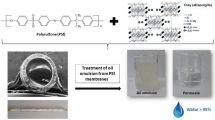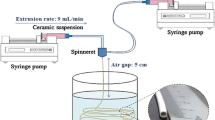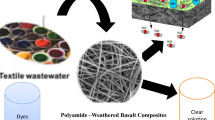Abstract
The negative effects of dye-contaminated wastewater on humans and the environment are well known, so the wastewater must be treated carefully before discharge into the environment. To overcome those impacts, the search for environmentally friendly and low-cost materials is essential, especially in developing countries The objective of the present study was to determine the feasibility of using bauxite from Malaysia as a new and efficient ceramic, hollow-fiber membrane for the degradation of reactive dyes in wastewater. A porous, hollow-fiber membrane was fabricated from bauxite (BHFM) using a phase-inversion technique, followed by sintering at various temperatures. The BHFM consisted of two types of voids, having either a finger-like or a sponge-like structure. As the sintering temperature was increased, the porosity of the BHFM decreased from 46.5 to 9.5%. The greatest mechanical strength of 308.1 MPa was achieved when the BHFM was loaded with 55 wt.% of bauxite and sintered at 1450°C. The remaining 45 wt.% consisted of solvent, polymer binder, and dispersant. The BHFM functioned well as a membrane for microfiltration and a support membrane for ultrafiltration. BHFM with loading of 45 wt.%, 50 wt.%, and 55 wt.% successfully eliminated 90%, 94%, and 98% of 10 ppm reactive dye (RB5) when sintered at the highest temperature.











Similar content being viewed by others
REFERENCES
Ali, M.S., Ariff, A.H.M., Jaafar, C.N.A., Tahir, S.M., Mazlan, N., Maori, K.A., & Naser, H. (2017). Factors affecting the porosity and mechanical properties of porous ceramic composite materials. In: Reference Module in Materials Science and Material Engineering. Elsevier.
Bauxite Index. (2020). https://thebauxiteindex.com/en/cbix/industry-101/bauxite-101/mineralogy/impurities
Bhuiyan, M. A., Hoque, S. M., & Choudhury, S. (2010). Effects of sintering temperature on microstructure and magnetic properties of NiFe2O4 prepared from nano size powder of NiO and Fe2O3. Journal of Bangladesh Academy of Science, 34, 189–195.
Cao, J., Dong, X., Lia, L., Dong, Y., & Hampshire, S. (2014). Recycling of waste fly ash for production of porous mullite ceramic membrane supports with increased porosity. Journal of the European Ceramic Society, 34, 3181–3194.
Choo, T. F., Salleh, M. A. M., Kok, K. Y., & Matori, K. A. (2019). A review on synthesis of mullite ceramics from industrial wastes. Recycling, 4(3), 39.
Coey, J.M.D., Venkatesan, M., & Xu, H. (2013). Introduction to magnetic oxides. Pp. 1–49 in: Functional Metal Oxides: New Science and Novel Applications (S.B. Ogale, T.V. Venkatesan, and M.G. Blamire, editors). Wiley, New Jersey.
Dong, L. L., Xiao, B., Liu, Y., Li, Y. L., Fu, Y. Q., Zhao, Y. Q., & Zhang, Y. S. (2018). Sintering effect on microstructural evolution and mechanical properties of spark plasma sintered Ti matrix composites reinforced by reduced grapheme oxides. Ceramics International. https://doi.org/10.1016/j.ceramint.2018.06.252.
Ebbesen, S. D., Jensen, S. H., Hauch, A., & Mogensen, M. B. (2014). High temperature electrolysis in alkaline cells, solid proton conducting cells, and solid oxide cells. Chemical Review, 114, 10697–10734.
Guillen, G. R., Pan, Y., Li, M., & Hoek, E. M. V. (2011). Preparation and characterization of membranes formed by nonsolvent induced phase separation: a review. Industrial and Engineering Chemistry Research, 50, 3798–3817.
Jeon, S., Rajabzadeh, S., Okamura, R., Ishigami, T., Kato, S. H. N., & Matsuyama, H. (2016). The effect of membrane material and surface pore size on the fouling properties of submerged membranes. Water, 8, 602–606.
Kingsbury, B. F. K., Wu, Z., & Li, K. (2010). A morphological study of ceramic hollow fiber membranes: a perspective on multifunctional catalytic membrane reactors. Catalysis Today, 156, 306–315.
Lawrence, R. & Jiang, Y. (2017). Porosity, pore size distribution, micro-structure. Pp. 39–71 in: Bio-aggregates Based Building Materials (S. Amziane and F. Collet, editors). RILEM State-of-the-Art-Reports; Vol. 23. Springer International Publishing, The Netherlands. https://doi.org/10.1007/978-94-024-1031-0_2
Li, L. L., Chen, M. L., & Dong, Y. C. (2016). A low-cost alumina-mullite composite hollow fiber ceramic membrane fabricated via phase inversion and sintering method. Journal European Ceramic Society. https://doi.org/10.1016/j.jeurceramsoc.2016.02.020.
Liu, S., & Li, K. (2003). Preparation TiO2/Al2O3 composite hollow fiber membranes. Journal of Membrane Science, 218, 269–277.
Liu, S., Li, K., & Hughes, R. (2003). Preparation of porous aluminium oxide (Al2O3) hollow fiber membranes by a combined phase-inversion and sintering method. Ceramics International, 29, 875–881.
Ma, H., Yoon, K., Rong, L., Mao, Y., Mo, Z., Fang, D., Hollander, Z., Gaiteri, J., Hsiao, B. S., & Chu, B. (2010). High-flux thin-film nanofibrous composite ultrafiltration membranes containing cellulose barrier layer. Journal of Materials Chemistry, 20, 4692–4704.
Meng, Y., Gong, G. H., Wei, D. T., & Yin, Z. (2014). Comparative microstructure study of high strength alumina and bauxite insulator. Ceramic International, 40, 10677–10684.
Rajput, H., Verma, A., Kaur, M., Kaur, T. J., & Toor, A. P. (2016). Heterogeneous solar photo-Fenton degradation of reactive Black 5 using foundry sand and fly ash: value addition to waste. Journal of Environmental Engineering and Landscape Management, 24, 124–132.
Ren, Q., Li, H., Wu, X., Huo, Z., Hai, O., & Lin, F. (2018). Effect of the calcining temperatures of low-grade bauxite on the mechanical property of mullite ceramics. International Journal of Applied Ceramic Technology, 15, 554–562.
Sabbatini, P., Yrazu, F., Rossi, F., Thern, G., Marajofsky, A., & Fidalgo de Cortalezzi, M. M. (2010). Fabrication and characterization of iron oxide ceramic membranes for arsenic removal. Water Research, 44, 5702–5712.
Sarkar, N., & Kim, I. J. (2015). Porous Ceramics. Intech Open Publication.
Setz, F. L. G., Koshimizu, L., de Mello-Castanho, S. R. H., & Morelli, M. R. (2012). Rheological analysis of ceramics suspensions with high solids loading. Materials Science Forum, 727–728, 646–651.
Sharif, N. S. A., Mohamed, J. J., Derita, H. S., Ahmad, Z. A., Abdullah, M. Z., Mohamad, H., & Yusoff, W. A. W. (2014). The effect of sintering conditions on the microstructure and electrical properties of Pb(Zr0.52Ti0.4)O3 ceramic. Journal of Mechanical Engineering and Sciences, 6, 901–906.
Silvestre, J., Silvestre, N., & de Brito, J. (2015). An overview on the improvement of mechanical properties of ceramics nanocomposites. Journal of Nanomaterials. https://doi.org/10.1155/2015/106494.
Xiao, M., Chen, J., Kang, J., Chen, K., Wu, D., & Gao, N. (2018). Effect of heat treatment process on mechanical properties and microstructure of FeAlCoCrNiTi0.5 alloy. AIP Advance, 8, 095322.
ACKNOWLEDGMENTS
The authors gratefully acknowledge financial support from the Ministry of Education Malaysia under the Higher Institution Centre of Excellence Scheme (Project Number: R.J090301.7809.4J430) and Universiti Teknologi Malaysia under the Transdisciplinary Research Grant (Project number: Q.J130000.3509.05G75), Malaysia Research University Network (MRUN) Grant (Project number: R.J130000.7809.4L867), and UTM Grant Award (Project number: R.J130000.7709.5M003). The authors thank Aras Kuasa Sdn Bhd for the research sample and the Advanced Research Technology Research Centre (AMTEC), Universiti Teknologi Malaysia for the technical support and services provided.
Funding
Funding sources are as listed in the acknowledgments.
Author information
Authors and Affiliations
Corresponding author
Ethics declarations
Conflict of Interest
The authors declare that they have no conflict of interest.
Rights and permissions
About this article
Cite this article
Ismail, N.J., Othman, M.H.D., Abu Bakar, S. et al. FABRICATION OF CERAMIC, HOLLOW-FIBER MEMBRANE: THE EFFECT OF BAUXITE CONTENT AND SINTERING TEMPERATURE. Clays Clay Miner. 68, 309–318 (2020). https://doi.org/10.1007/s42860-020-00076-8
Received:
Revised:
Accepted:
Published:
Issue Date:
DOI: https://doi.org/10.1007/s42860-020-00076-8




